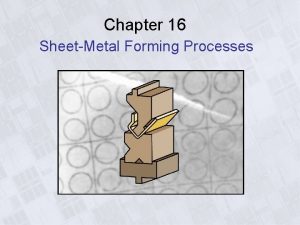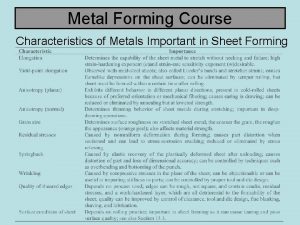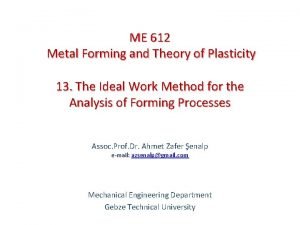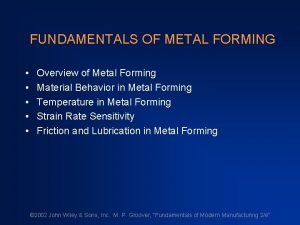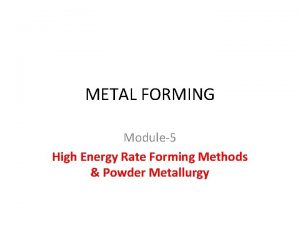Fundamental of forming process Introduction Metal forming includes









- Slides: 9

Fundamental of forming process

Introduction Metal forming includes a large group of manufacturing processes in which plastic deformation is used to change the shape of metal workpieces. Deformation results from the use of a tool, usually called a die in metal forming, which applies stresses. Stresses applied to plastically deform the metal are usually compressive, stretch, bend, or shear stresses to the metal. To be successfully formed, a metal must possess certain properties. Desirable properties include low yield strength and high ductility. Metal forming processes can be classified into two basic categories: bulk deformation processes and sheet metalworking, and these two categories contain many processes as shown in figure 4. 1

Fig 4 -1

Bulk Deformation Processes: Bulk deformation processes are generally characterized by significant deformations and massive shape changes, and the surface area-to-volume of the work is relatively small. The term bulk describes the work parts that have this low area tovolume ratio. Figure 4 -2 shows some common bulk deformation processes. Sheet Metalworking: Sheet metalworking processes are forming and cutting operations performed on metal sheets, strips, and coils. The surface area-to-volume ratio of the starting metal is high; thus, this ratio is a useful means to distinguish bulk deformation from sheet metal processes. Pressworking is the term often applied to sheet metal operations because the machines used to perform these operations are presses. Sheet metal operations are always performed as cold working processes and are usually accomplished using a set of tools called a punch and die. The basic sheet metal operations are sketched in Figure 4 -3.

Figure 4 -2

Figure 4 -3

Material Behavior in Metal Forming The behavior of metals during forming can be obtained from the stress–strain curve. In metal forming, the plastic region is of primary interest because the material is plastically and permanently deformed in these processes. In the plastic region, the metal’s behavior is expressed by the equation: σ=Kεn (4. 1) Where K = the strength coefficient, MPa (lb/in 2); and (n) is the strain-hardening exponent. The stress σ and strain ε in the equation are true stress and true strain. Flow Stress The flow curve describes the stress–strain relationship in the region in which metal forming takes place. For most metals at room temperature, the stress–strain plot of Figure 4. 4 indicates that as the metal is deformed, its strength increases due to strain hardening. The stress required to continue deformation must be increased to match this increase in strength. Flow stress is defined as the instantaneous value of stress required to continue deforming the material to keep the metal ‘‘flowing. ’’ It is the yield strength of the metal as a function of strain, which can be expressed: Yf =K εn Where Yf = flow stress MPa (Ib/in 2) (4. 2)

Fig 4 -4

